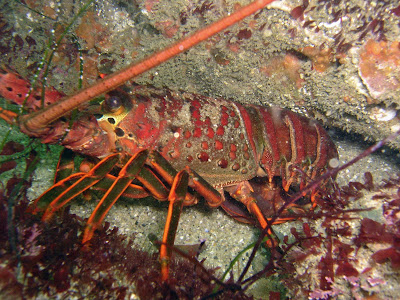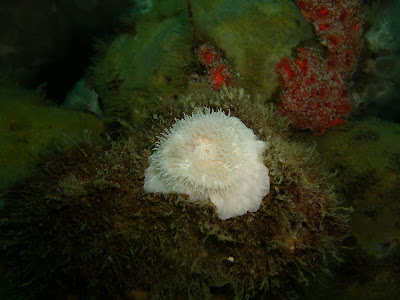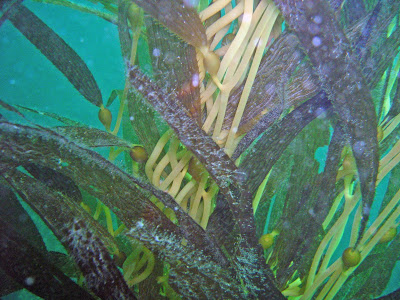There were 17 divers and four guides, so the boat was packed. Paul and I have dived about the same amount, so we were pretty well matched. There was another very experienced pair in our group, so Matt really didn't have much to do. He did try hard though. This was his first time leading dives since being certified as a Divemaster and he was nervous. My internship was to assist him. Several of the other divers in other groups were students.
We gathered as a loose group at the stern of the boat and did a free descent down to the top of the reef and then over to the wreck. We hung out there for a few minutes and then began a slow ascent back up along the wall of the reef. This Banded Coral Shrimp with the Hawaiian Squirrelfish in the background was an interesting photo I thought. It came out even better than I had hoped.

Banded Coral Shrimp
Under the wing was a big Flameback Coral Shrimp.

Flameback Coral Shrimp
This is an unusual specimen of Hawaiian Spiky Sea Cucumber. The spikes are in pairs and there are lots of little additional spikes.

Hawaiian Spiky Sea Cucumber

Hawaiian Swimming Crab
As Paul and I were running low on no-deco time, we began a slow ascent as Matt led the group in a fairly long swim past the boat and out to the south. It soon became obvious that he was lost. He finally decided he needed to surface and figure out where we were, so we did a three minute safety stop and came up. We were only 120 feet or so from the boat, but it was kind of funny.
During the surface interval we ran in to the dock and got more tanks for the third dive. We ran back out to Shallow LCU and tried to tie up, but they could not find the mooring ball. The light conditions were bad enough with the light rain, poor visibility and late afternoon and they just couldn't see, so we finally abandoned that and went to Turtle Reef instead.
When we got tied up, we all geared up and headed back into the water for the second dive. Matt wanted to lead the four of us on a tour, but I was taking a few photos and Paul and I just conveniently got left behind, so we did our own thing instead.
This Knobby Spindle was laying right out in the open upside down. You can see the snail inside.

Knobby Spindle
I saw this Striated Cone hanging from the roof of a little overhang. When I shot the photo, I thought that the snail was in the shell. However, on closer examination on the computer, I discovered a single red and yellow striped leg poking out at the left end. This shell is inhabited by a Cone Shell Hermit Crab.

Striated Cone & Cone Shell Hermit Crab
This dive was turning into a hermit crab dive at this point.

Bloody Hermit Crab
Right under the boat, we discovered this Hairy Yellow Hermit Crab in an old Partridge Tun shell. This is a large crab in a large shell - the shell is about the size of a large grapefruit.

Hairy Yellow Hermit Crab
This is what the shell looks like with the crab all tucked inside.

Partridge Tun (shell)
Paul was getting pretty chilly at this point since he was diving without a wetsuit, so we ended the dive and climbed back on the boat, even though we both still had about 1400 psi left.
After about a 45 minute surface interval, we got back in for the night dive since it had gotten dark. This time I was able to talk Paul into putting on a wetsuit.
Once again, we started out with Matt, but he soon disappeared and so I took Paul and we went in a different direction from everyone else. They reported back afterwards that they saw lots of eels, but for Paul and I this was a macro dive. Not many large critters, but lots of little ones and many that I had never seen before. It was a good photo dive!
I have never seen anemones in Hawaii, but I did tonight! This one is undescribed other than assignment to a family.

Anemone (family Edwardsiidae)

Hawaiian Swimming Crab
I see shells all the time, but only rarely and at night, do I see the critter that lives in them and makes them. This is one of my favorite photos of these dives!

Pimpled Basket
I almost missed this little (1/2 inch) worm. If it had not been so flame red, I would have missed it. I thought it was a nudibranch, but could not find it in any book or on-line, so I sent a copy of the photo to Cory Pittman at UH, one of the world's foremost authorities on nudibranchs, and asked what it was. Lo and behold, it is an undescribed flatworm instead. Pretty cool!

Thysanozoon or Acanthozoon sp. Flatworm (undescribed)

Christmas Tree Worms & Laurent's Hermit Crabs
This tiny shrimp is a little hard to see. The eyes are obvious but you may have to study it a while to see the transparent tail and head. About 3/4 inch long.

Bicolor Sand Shrimp
Known as the piranha of the sea, these guys eat everything - if it grows in the ocean, they eat it. The Japanese delicacy Fugu is made from a close relative of this fish. It is the raw fish dish that is extremely toxic and people play Russian roulette eating it. This fish is even more toxic, especially the skin and the mucous on it. Just handling it can be deadly! and people are afraid of sharks!?!

Stripebelly Puffer
One of the real benefits of night dives is that these little (1-1/2 to 2 inch) rare scorpionfish come out where you can see and photograph them.


Coral Scorpionfish (rare)

Cheekspot Scorpionfish
This tiny ( about the size of a dime) nudibranch was the first I have ever seen.

Polygon Pleurobranch
This one also. I was really sad that the two photos I took, both came out poorly.

Orange Gumdrop (nudibranch)

Coral Scorpionfish (rare)
Paul and I ended the dive after about 45 minutes even though we both had about 1600 psi left. Not good form to keep the whole boat waiting and that was the planned duration for the dive.












































